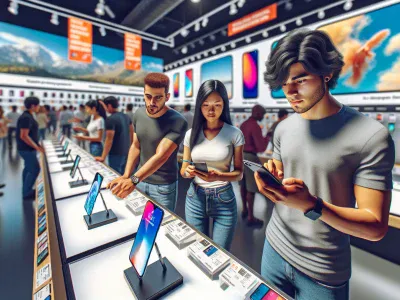Comparison of Samsung Galaxy vs iPhone: Which Smartphone is Right for You?
Choosing between Samsung Galaxy and iPhone often feels like standing at a crossroads, each path promising innovation and cutting-edge technology. These two giants dominate the smartphone world, sparking endless debates over performance, design, and features. Whether you’re drawn to Samsung’s bold versatility or Apple’s seamless ecosystem, the choice isn’t always straightforward.
Imagine holding a sleek device that fits your lifestyle perfectly—one that enhances productivity, captures stunning memories, and keeps you connected effortlessly. But which brand truly delivers on its promises? From camera quality to software experience, every detail matters when deciding which phone deserves a spot in your pocket.
This comparison dives deep into what sets Samsung Galaxy and iPhone apart, helping you uncover which one aligns with your needs. Whether you’re a loyal fan or a curious shopper, you’re about to discover the key differences that could shape your next upgrade.
Overview Of Samsung Galaxy And iPhone
Samsung Galaxy and iPhone represent two of the most prominent smartphone lineups globally. Their distinct ecosystems, design philosophies, and technological innovations have cultivated a loyal user base for each brand.
Brief History Of Samsung Galaxy
Samsung Galaxy launched its first device, the Galaxy i7500, in 2009, marking the company’s entry into the smartphone market. By 2010, the Galaxy S series became a turning point, showcasing Samsung’s advanced hardware design and Android capabilities. Over the years, Samsung introduced features like AMOLED displays, S Pen, and foldable technology, solidifying its position as a market leader.
The Galaxy Note series, introduced in 2011, pioneered the phablet trend with larger displays and stylus support. More recently, the Galaxy Z Fold and Flip have redefined smartphones with flexible screen innovation. Samsung’s partnership with Google ensures seamless Android updates, while its proprietary One UI provides a unique experience.
Brief History Of iPhone
Apple unveiled the iPhone in 2007 under Steve Jobs’ leadership, revolutionizing mobile technology. Combining a touchscreen interface with iOS, it set a new standard for smartphones. Apple entered the app ecosystem in 2008 with the App Store, fostering innovation and developer collaboration.
In 2010, the iPhone 4 introduced the Retina Display, offering unmatched screen clarity. Subsequent advancements like Face ID, computational photography, and system-wide optimization highlight Apple’s commitment to premium performance. The iPhone X in 2017 marked a design shift with edge-to-edge displays and Face ID integration. Apple’s tight hardware-software ecosystem enhances user experience and device longevity.
Both Samsung Galaxy and iPhone continue setting industry benchmarks, driving competition in design, software, and innovation.
Design And Build
The design and build quality of a smartphone significantly influence user experience. Both Samsung Galaxy and iPhone adopt distinct approaches to craftsmanship, materials, and functional design elements.
Material And Durability
Samsung Galaxy devices often use a combination of Gorilla Glass and aluminum or Armor Aluminum in flagship models like the Galaxy S23. This enhances resistance to scratches and impacts. On the other hand, newer foldable Galaxy models, such as the Z Fold 5, incorporate flexible glass and hinge protection mechanisms, prioritizing innovation alongside durability.
iPhones, since the iPhone 12, integrate Ceramic Shield glass, co-developed with Corning, and surgical-grade stainless steel or aluminum frames. These materials boost robustness against drops while maintaining a premium look. For instance, the iPhone 14 Pro employs a polished stainless-steel frame, merging strength and elegance effectively.
Each brand achieves high IP ratings for water and dust resistance—IP68 for flagship models—but the designs differ. Samsung, known for venturing into foldable devices, faces unique challenges in hinge sealing. iPhones focus on maintaining consistent durability in monolithic designs, catering better if you value long-term drop resistance under uniform use cases.
Aesthetics And Ergonomics
Samsung Galaxy emphasizes futuristic aesthetics with edge-to-edge displays, often featuring sharper curves in models like the Galaxy S22 Ultra. These designs cater to users drawn to immersive experiences and stylus integration, as in models supporting the S Pen. But, curved edges might compromise ease of handling for some users.
Apple takes a minimalistic approach with flat edges and symmetrical bezels, creating a distinct visual identity. iPhone 14 Pro Max demonstrates this ethos—its matte glass back reduces fingerprints, while flat-edged designs improve your grip during extended use. The consistency in Apple’s design language ensures brand recognizability across generations.
Both brands tailor ergonomics for varied preferences. Samsung focuses on leveraging larger screens for productivity or foldability for versatility. In contrast, iPhones lean towards balance and simplicity, enhancing usability across their lineup.
Display Quality
When comparing the Samsung Galaxy and iPhone, display quality is a critical factor that influences multimedia experiences and daily usability. Both brands, known for their advancements in screen technology, offer impressive displays tailored to different user preferences.
Screen Size And Resolution
Samsung Galaxy devices often feature larger screens, with sizes reaching up to 7.6 inches on foldable models like the Galaxy Z Fold5. These devices provide high resolutions, such as 3200 x 1440 pixels on flagship models, delivering sharp visuals suitable for multitasking and gaming. In contrast, iPhone screens, like the 6.7-inch display on the iPhone 15 Pro Max, prioritize optimized PPI (pixels per inch) with resolutions like 2796 x 1290 pixels, ensuring clear and vivid details for streaming or editing photos.
Larger screens on Samsung models are advantageous for users who engage in split-screen activities or immersive video playback. Meanwhile, iPhones’ precisely calibrated displays are better suited for those who value consistency in color and clarity for professional-grade content.
Display Technologies
Samsung utilizes AMOLED and Dynamic AMOLED 2X technologies across its premium devices. These technologies offer exceptional contrast ratios, deep blacks, and vibrant color profiles, enhancing the viewing experience in HDR content and direct sunlight. Apple employs Super Retina XDR OLED technology, focusing on accurate color reproduction, uniform brightness, and lower power consumption.
For example, Samsung’s adaptive refresh rates (up to 120Hz) in devices such as the Galaxy S23 Ultra enable smoother interactions while conserving energy when static images are displayed. Similarly, iPhones support ProMotion technology with variable refresh rates, delivering comparable fluidity in animations and gaming while maintaining battery efficiency.
Both brands integrate features like True Tone and Eye Comfort Shield, but Samsung provides more customization options, such as vivid mode, to cater to user preferences. Apple’s attention to precision benefits photographers and designers needing highly accurate displays for color-critical tasks.
Performance And Software
Performance and software define the core experience of any smartphone. Samsung Galaxy and iPhone devices cater to different preferences by offering distinct processors, operating systems, and optimization levels.
Processor Capabilities
Samsung Galaxy devices use Exynos or Snapdragon chips, depending on the region. For example, the Galaxy S23 Ultra features the Snapdragon 8 Gen 2 processor in most markets, delivering lightning-fast performance for gaming and multitasking. Apple’s iPhones consistently integrate their exclusive A-series Bionic chips, such as the A17 Pro in the iPhone 15 Pro Max, which utilizes a 3nm architecture to enhance speed and energy efficiency.
Samsung processors are known for multi-core efficiency, excelling in handling resource-intensive tasks like video editing or running high-end games. But, iPhone chips often outperform in single-core tasks, ensuring smoother performance in daily activities and app launches. Benchmarks highlight this difference, with the A-series chips often leading in capabilities like AI-driven tasks and graphics rendering.
Operating System Features
Samsung devices operate on Android, with the One UI skin adding features like enhanced multitasking and customization options. You can adjust home screen layouts, integrate productivity-centric widgets, and even use Samsung DeX for a desktop-like experience. The Android ecosystem allows for broader app compatibility, supporting cross-platform integrations like using Google Workspace or Microsoft 365 seamlessly.
iPhones rely on iOS, offering a streamlined and secure experience with frequent software updates. Features like FaceTime, iMessage, and integration with the Apple ecosystem—such as seamless connectivity between iPhones, iPads, and Macs—enhance user convenience. Apple’s focus on privacy, evident in settings like App Tracking Transparency, appeals to those prioritizing data security.
While Samsung’s flexibility caters to tech-astute users, Apple’s simplicity and ecosystem integration create a cohesive user experience.
Camera Performance
Camera performance remains a critical differentiator between the Samsung Galaxy and iPhone, influencing many purchasing decisions due to advancements in smartphone photography.
Photo Quality
Samsung Galaxy smartphones emphasize vibrant colors, enhanced using advanced AI algorithms. For instance, the Galaxy S23 Ultra features a 200 MP main sensor that delivers exceptional detail in daylight and low-light conditions. Nightography mode on Galaxy devices, supported by multi-frame processing, excels in capturing images in dim environments, making it a suitable choice for nocturnal photography enthusiasts.
iPhones, such as the iPhone 15 Pro Max, prioritize natural tones and contrast, thanks to Deep Fusion and Photonic Engine technologies. They produce more realistic colors without over-processing, appealing to professionals requiring accurate representation. ProRAW mode offers unmatched control over post-processing, providing fine detail and dynamic range for users keen on photo editing.
Portrait mode showcases noticeable differences. Samsung utilizes depth sensors to create precise bokeh effects, while Apple uses machine learning to offer real-time adjustments of focus and aperture, ensuring flattering portraits.
Video Recording Capabilities
Samsung Galaxy devices lead in versatility, with features like 8K video recording at 30 fps on the Galaxy S23 Ultra, delivering ultra-high-resolution clips. Super Steady mode enhances stabilization even during intense motion, catering to vloggers and content creators.
Apple iPhones set a standard in cinematic videography, with the iPhone 15 Pro Max offering ProRes video recording at 4K 60 fps directly to an external SSD. Cinematic mode enables precise control of depth of field, mimicking professional cameras for storytelling purposes. iPhone videos often appear more lifelike due to HDR implementation via Dolby Vision.
Both devices include advanced audio recording capabilities. Galaxy phones use directional microphones for immersive sound, while iPhones employ spatial audio for realistic playback. Choose Samsung if you prefer resolution flexibility, or opt for iPhone when prioritizing cinematic editing features.
Battery Life And Charging
Battery performance plays a crucial role in determining daily usability and overall convenience. Samsung Galaxy and iPhone have distinct strengths in battery longevity and charging technologies that cater to different user preferences.
Battery Longevity
Samsung Galaxy devices, like the Galaxy S23 Ultra with a 5000mAh battery, often showcase larger capacities, enabling extended use for power-intensive tasks such as gaming and multitasking. Apple’s iPhone series, including the iPhone 15 Pro Max, balances its smaller battery capacity, estimated around 4350mAh, with superior optimization through the iOS ecosystem and the A17 Pro chip.
In real-world tests, Samsung Galaxy devices impress with consistent endurance for heavy productivity sessions, while iPhones excel in efficiency, making the most of their hardware for extended casual browsing or video playback. Battery longevity varies depending on usage scenarios; Galaxy devices may lead in scenarios requiring multitasking, while iPhones often excel in standby times.
Charging Technologies
Samsung adopts versatile charging technologies like 45W fast charging for specific devices, wireless charging through Qi standards, and reverse wireless charging for accessories or other devices. With a compatible adapter, a Galaxy device charged to 50% in as little as 30 minutes demonstrates Samsung’s focus on speed and convenience.
Apple integrates fast-charging capabilities, with the iPhone 15 Pro Max reaching 50% charge in about 30 minutes using a 20W adapter. Also, MagSafe technology provides a seamless wireless charging solution, ensuring precise alignment for efficiency. But, the Lightning port, used until recently, limits charging speed compared to Galaxy’s USB-C counterparts.
Both brands meet diverse user needs. You might favor Samsung for its high-speed wired charging options or iPhone for its simplified, ecosystem-driven solutions. Whether you’re seeking versatility in charging methods or prioritizing efficiency, both Samsung and Apple deliver dependable performance.
Pricing And Value For Money
Samsung Galaxy and iPhone stand at different price points, offering unique value propositions for various user preferences and budgets.
Price Range Comparison
Samsung Galaxy devices cover a broader price spectrum, catering to diverse audiences. Entry-level models such as the Galaxy A14 start at $199, making them accessible to budget-conscious buyers. Premium devices like the Galaxy S23 Ultra, priced at $1,199, feature cutting-edge capabilities suitable for tech enthusiasts. Foldable options, including the Galaxy Z Fold5, range from $1,799, offering innovation for productivity-focused users.
iPhones tend to occupy the mid-to-premium range. Models like the iPhone SE start at $429, offering Apple ecosystem access at lower costs. Flagship devices, like the iPhone 15 Pro Max, begin at $1,199, focusing on high-end performance and refined craftsmanship. Unlike Samsung, Apple’s lineup avoids entry-level pricing, targeting specific consumer segments.
In comparing the two, Samsung’s varied pricing appeals to a wider audience, while Apple’s consistent premium pricing reinforces its luxury brand identity.
Long-Term Value
iPhones retain value better over time due to software longevity and brand perception. With up to five years of iOS updates, devices like the iPhone 13 remain relevant for extended periods. This extends their resale value, often exceeding 70% after two years, especially among enthusiasts valuing Apple’s ecosystem.
Samsung Galaxy devices, though equipped with high-end features, experience faster depreciation. For example, flagship models lose up to 50% of their value within a year, driven by frequent hardware updates. But, features like expandable storage in older models and diverse design innovations offset this depreciation for specific users.
When evaluating long-term value, iPhones benefit users seeking sustained utility and resale gains, while Samsung devices excel for those prioritizing initial features at competitive prices.
Conclusion
Choosing between a Samsung Galaxy and an iPhone eventually depends on what matters most to you. Whether it’s display quality, performance, camera capabilities, or ecosystem integration, each brand offers unique strengths that cater to different lifestyles and preferences.
By understanding your priorities and how you use your smartphone daily, you can select the device that aligns best with your needs. Both Samsung and Apple continue to push boundaries, ensuring you’ll get a feature-packed, high-quality smartphone no matter which option you choose.
- Understanding the Difference Between Annulled and Divorced: Key Legal and Emotional Insights - October 30, 2025
- Ibuprofen vs. Aspirin: A Comprehensive Comparison - October 30, 2025
- The Difference Between Kosher Salt and Other Salts: Texture, Flavor, and Best Uses Explained - October 30, 2025







